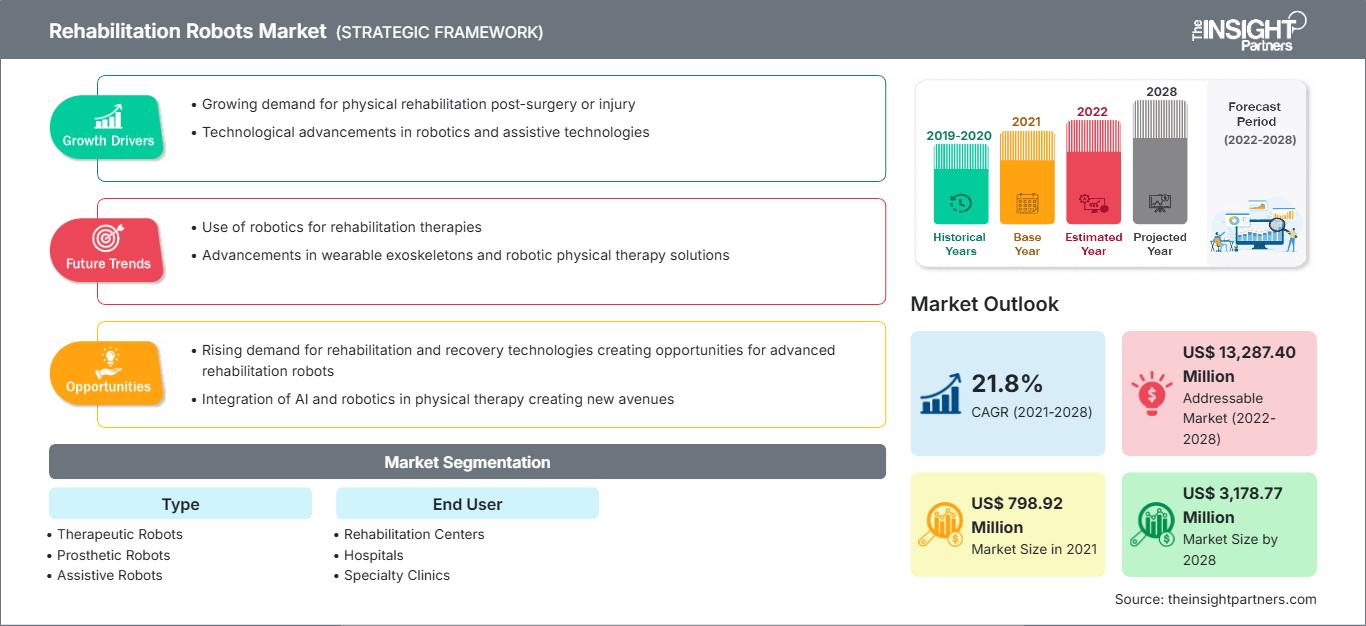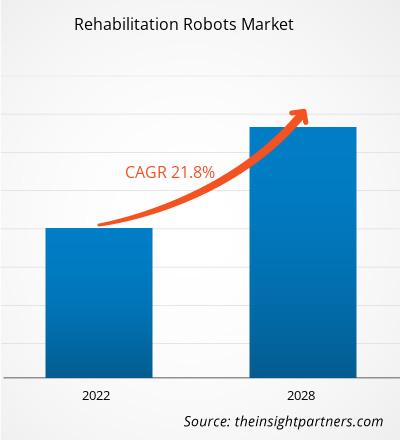El mercado de robots de rehabilitación se valoró en 798,92 millones de dólares estadounidenses en 2021 y se prevé que alcance los 3.178,77 millones de dólares estadounidenses en 2028; se espera que crezca a una tasa de crecimiento anual compuesta (TCAC) del 21,8% entre 2021 y 2028.
Los robots de rehabilitación se utilizan en el proceso de recuperación de pacientes con discapacidad para ayudarles a ponerse de pie, mantener el equilibrio y caminar. Estos robots deben adaptarse al ritmo de los humanos y sus movimientos; por lo tanto, durante su fabricación, los fabricantes deben garantizar que se ajusten al progreso del paciente. Se prevé que el mercado de robots de rehabilitación experimente un crecimiento significativo en los próximos años debido a factores como el aumento de la población geriátrica, los accidentes cerebrovasculares y el entrenamiento asistido por robots en la terapia de rehabilitación. Sin embargo, el elevado coste de los dispositivos podría frenar el crecimiento del mercado.
Perspectivas del mercado
Obtendrá personalización gratuita de cualquier informe, incluyendo partes de este informe, análisis a nivel de país y paquetes de datos de Excel. Además, podrá aprovechar excelentes ofertas y descuentos para empresas emergentes y universidades.
Mercado de robots de rehabilitación: Perspectivas estratégicas

- Obtenga las principales tendencias clave del mercado que se describen en este informe.Esta muestra GRATUITA incluirá análisis de datos, que abarcarán desde tendencias de mercado hasta estimaciones y pronósticos.
Aumento de la población geriátrica, accidentes cerebrovasculares y entrenamiento asistido por robot en terapia de rehabilitación
Con el auge de la investigación en robótica de rehabilitación, la fabricación y el despliegue de robots terapéuticos de rehabilitación están en aumento en todo el mundo. Japón y China se encuentran entre los países de Asia-Pacífico con una alta población de edad avanzada; estos países, así como otras naciones en desarrollo de la región, están experimentando avances en tecnología médica. Según el Ministerio del Interior y Comunicaciones, en 2017 había aproximadamente 35,2 millones de personas en Japón mayores de 65 años, y se prevé que esta cifra aumente a 36,2 millones para 2020. Por lo tanto, las principales empresas del sector sanitario están dispuestas a invertir en el desarrollo de tecnologías avanzadas para brindar atención a los adultos mayores de la región. En consecuencia, el aumento de la población de edad avanzada y la creciente prevalencia de accidentes cerebrovasculares, que provocan inmovilidad, se encuentran entre los factores importantes que impulsan la demanda de robots de rehabilitación.
La terapia de rehabilitación robótica se utiliza para proporcionar entrenamiento de alta intensidad a pacientes con trastornos motores causados por enfermedades de la médula espinal o accidentes cerebrovasculares. Según los Centros para el Control y la Prevención de Enfermedades (CDC), el accidente cerebrovascular es una de las principales causas de discapacidad grave a largo plazo en Estados Unidos. La fatiga, la hemiparesia y la dificultad para caminar son algunas de las consecuencias de un accidente cerebrovascular. Además, los robots de rehabilitación ofrecen un entrenamiento personalizado, orientado a tareas, prolongado, intensivo, estandarizado y reproducible a pacientes que han sufrido un accidente cerebrovascular u otras lesiones cerebrales no progresivas. Por lo tanto, la creciente demanda de servicios de salud mejores y más rápidos impulsa el crecimiento del mercado global de robots de rehabilitación.
Información sobre tipos
Según su tipo, el mercado de robots de rehabilitación se segmenta en robots terapéuticos, robots de asistencia, exoesqueletos y prótesis robóticas. El segmento de exoesqueletos representó la mayor cuota de mercado en 2021 y se prevé que registre la mayor tasa de crecimiento anual compuesto (TCAC) durante el período de pronóstico.CAGR during the forecast period.
Usuario final
Según el usuario final, el mercado de robots de rehabilitación se segmenta en hospitales, centros de rehabilitación y clínicas especializadas. El segmento de centros de rehabilitación ostentó la mayor cuota de mercado en 2021 y se estima que registrará la mayor tasa de crecimiento anual compuesto (TCAC) durante el período de previsión.CAGR during the forecast period.
Los actores que operan en el mercado de robots de rehabilitación han adoptado mayoritariamente la estrategia de innovación de productos para satisfacer la cambiante demanda de los clientes en todo el mundo, lo que también les permite mantener su marca a nivel global.
Perspectivas regionales del mercado de robots de rehabilitación
Los analistas de The Insight Partners han explicado en detalle las tendencias y los factores regionales que influyen en el mercado de robots de rehabilitación durante el período de previsión. Esta sección también analiza los segmentos y la geografía del mercado de robots de rehabilitación en Norteamérica, Europa, Asia Pacífico, Oriente Medio y África, y Sudamérica y Centroamérica.
Alcance del informe de mercado de robots de rehabilitación
| Atributo del informe | Detalles |
|---|---|
| Tamaño del mercado en 2021 | 798,92 millones de dólares estadounidenses |
| Tamaño del mercado para 2028 | 3.178,77 millones de dólares estadounidenses |
| Tasa de crecimiento anual compuesto global (2021 - 2028) | 21,8% |
| Datos históricos | 2019-2020 |
| período de previsión | 2022-2028 |
| Segmentos cubiertos | Por tipo
|
| Regiones y países cubiertos | América del norte
|
| Líderes del mercado y perfiles de empresas clave |
|
Densidad de los actores del mercado de robots de rehabilitación: comprensión de su impacto en la dinámica empresarial
El mercado de robots de rehabilitación está creciendo rápidamente, impulsado por la creciente demanda de los usuarios finales debido a factores como la evolución de las preferencias de los consumidores, los avances tecnológicos y una mayor conciencia de los beneficios del producto. A medida que aumenta la demanda, las empresas amplían su oferta, innovan para satisfacer las necesidades de los consumidores y aprovechan las nuevas tendencias, lo que impulsa aún más el crecimiento del mercado.

- Obtenga una visión general de los principales actores del mercado de robots de rehabilitación.
Por tipo
- Robots con exoesqueletos
- Robots terapéuticos
- Robots de asistencia
- Robots protésicos
Usuario final
- Centros de rehabilitación
- hospitales
- Clínicas especializadas
Por geografía
- América del norte
- A NOSOTROS
- Canadá
- México
- Europa
- Reino Unido
- Alemania
- Francia
- Italia
- España
- El resto de Europa
- Asia Pacífico
- Porcelana
- Japón
- India
- Australia
- Corea del Sur
- Resto de Asia Pacífico
- Oriente Medio y África
- Emiratos Árabes Unidos
- Arabia Saudita
- Sudáfrica
- Resto de Oriente Medio y África
- América del Sur y Central
- Brasil
- Argentina
- El resto de Sudamérica y Centroamérica
Perfiles de empresas
- Corporación de Laboratorios Bionik
- Cyberdyne Inc.
- Ekso Bionics Holdings Inc
- Rewalk Robotics Ltd
- Hocoma Ag
- Compañía de robótica de rehabilitación limitada
- Kinova Inc
- Rex Bionics Ltd
- Corporación Toyota Motor
- Myomo Inc
- Análisis histórico (2 años), año base, pronóstico (7 años) con CAGR
- Análisis PEST y FODA
- Tamaño del mercado, valor/volumen: global, regional y nacional
- Industria y panorama competitivo
- Conjunto de datos de Excel
Informes recientes
Testimonios
Razón para comprar
- Toma de decisiones informada
- Comprensión de la dinámica del mercado
- Análisis competitivo
- Información sobre clientes
- Pronósticos del mercado
- Mitigación de riesgos
- Planificación estratégica
- Justificación de la inversión
- Identificación de mercados emergentes
- Mejora de las estrategias de marketing
- Impulso de la eficiencia operativa
- Alineación con las tendencias regulatorias




















 Obtenga una muestra gratuita para - Mercado de robots de rehabilitación
Obtenga una muestra gratuita para - Mercado de robots de rehabilitación